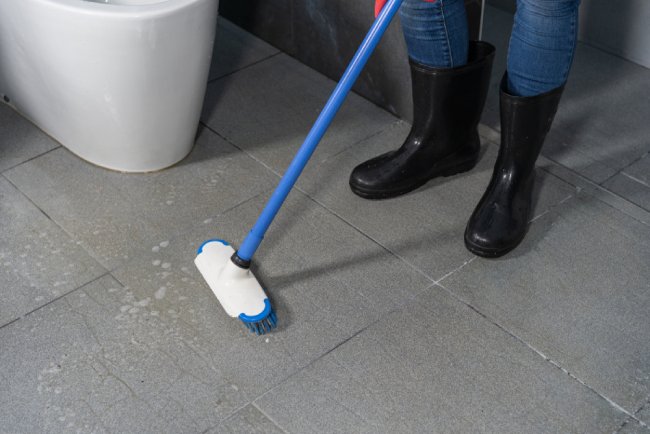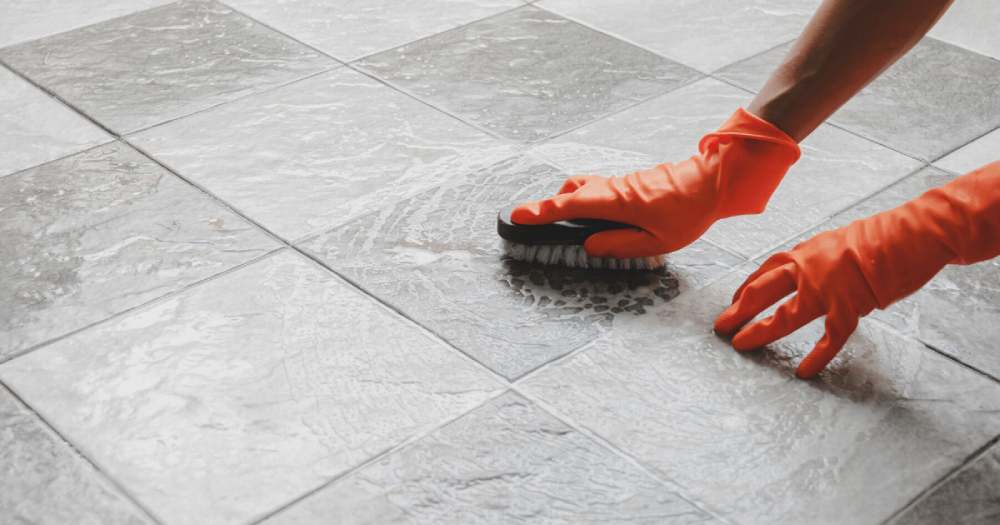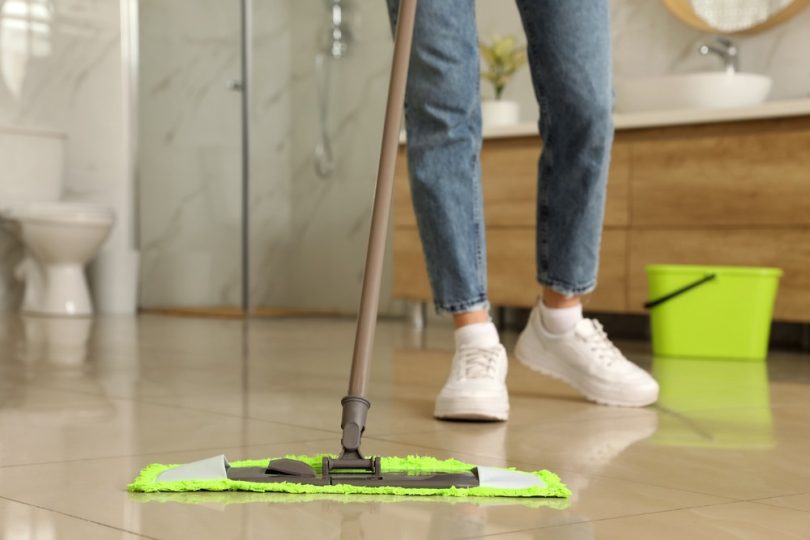Tile floors are ideal for the bathroom since tile is easy to clean and always looks nice. They also last a long time with the proper care. But how do you take good care of the floor?
Here we will offer tips on keeping tile floors clean, what cleaning agents work best, and how to clean bathroom tile floors effectively.
Bathroom Floor Tile Cleaning Methods

Supplies you need
- A cleaning agent
- Mop
- Vacuum/ dry sweeper
- Bucket of warm water
- Soft cloth
1. Dust mop
Dust mopping will not wash a tile floor, but it will remove dust and dirt that can scratch the floor while you wet mop. Use a clean dust mop every time you dust the floors.
2. Baking soda
Here is the most effective way to use baking soda as a tile cleaner.
In a spray bottle, add equal parts peroxide and baking soda (start with a ½ cup of each). Mix the ingredients, then place the lid on the container.
Next, spray your tile floor and let it sit for 10-15 minutes. Then use a damp, warm rag or mop to clean the floor. Finally, allow the tile floor to air dry.
3. Vinegar
In a bucket mix, water and vinegar 1:1 (1 cup of each). Dampen the rag or mop in the solution and wash the floor until clean. Then dry and buff the floor to a shine.
The vinegar’s hydrophobic nature helps pull the oily stains from the tile.
4. Scrub
If you choose to use a floor scrub, use one that is non-abrasive to avoid scratching the tile floor. Before using, check to see if the tile manufacturer recommends using floor scrubs.
5. Ammonia
Ammonia gives off the same toxic fumes as bleach, you will need adequate ventilation and gloves when working with ammonia to avoid lung and skin irritation.
Mix 1 cup water and ½ cup ammonia (a 2:1 mix) in a spray bottle. Spray onto the tile floor and allow it to sit for at least 1 hour. Then rinse the floor with a warm, damp cloth or mop.
If you can still smell the ammonia after rinsing the floor, rinse it a second time and let it air dry.
6. Lemon juice
Using uncut (no water) lemon juice, apply it with a cloth or a spray bottle on the tiles. Then wet mop or use a damp cloth and warm water to remove the lemon juice and clean the tiles.
For tough stains, apply some baking soda onto the spot after the lemon juice and let it sit for several minutes before cleaning with a damp, warm cloth. The weak acid in the lemon juice offers an effective cleaning product.
7. Heavy-duty cleaner
If you are looking to clean and sterilize filthy bathroom floor tiles, use a heavy-duty bathroom cleaner that has one of the following ingredients: ammonia, bleach, or baking soda.
Be super careful of the grout if you use steam as it causes the grout to erode over time.
8. All-purpose products
Mix three cups of all-purpose cleaner and five liters of warm water in a bucket. Dip your rag or mop in the solution and start cleaning from the corners inward. Be sure to clean the corners thoroughly.
Now mop yourself out of the bathroom by mopping towards the door. Make sure to dip and rinse your mop frequently to avoid moving dirt over the tile. Once the tile is clean, dry mop, the floor to prevent slips and falls.
The above method works excellent. If you prefer, there are instructions for using the all-purpose cleaner on the container if you wish to follow the manufacturer’s directions.
9. Water and bleach
Before mixing the bleach solution, make sure to ventilate the room. Bleach is noxious and can irritate the skin and lungs. Wear gloves all the time when cleaning with bleach.
Use a spray bottle and mix 1 ½ cups water with ½ cup bleach (3:1 solution). For larger bathrooms, you may need to mix a larger quantity.
Spray the floor with the solution. If the bleach smell is overwhelming, spray and rinse a small area of the tile floor at a time.
Rinse the floor with warm water and repeat the rinsing process (you want to rinse twice to ensure you have removed the bleach. Allow the floor to air dry.
10. Steam cleaning
A steam cleaner designed for floors is ideal for bathroom tiles. Fill the steamer with water following the manufacturer’s directions for steaming.
Do not use the steamer too long in one spot to avoid grout damage. Also, do not add a cleaning solution to the water unless it is recommended by the manufacturer of the steam cleaner.
How to Make a Cleaning Schedule for Bathroom Floor Tile
Mopping tile
Bathroom tile should be wet mopped or cleaned weekly. Cleaning up spills and stains as they happen will keep you from “scrubbing the stains” on the days you wash the floor.
Vacuuming tile
To avoid a dull finish and grit that can scratch tile floors, you should vacuum, dry mopped, or broom sweep weekly. Make sure you get the dirt out of the corners each time.
Cleaning the grout
Grout should be spot cleaned every two to three months. If you tend stains as they occur, it will be easier to spot clean.
Quick Tips for Bathroom Floor Tiles Cleaning

-
Bad knee solution
If you have bad knees or do not want to kneel on a wet floor, dry the floor using an old towel and move it with your feet. Start at the door and dry inwards, so you do not slip!
-
Clean up spots as they happen
Clean spills and spots as they happen. This will prevent a stain from developing and make mopping easier on floor washing days.
-
Wear gloves
Always wear gloves to protect your hands from acid-based solutions (vinegar and lemon juice) and harsher cleaners like ammonia and bleach.
-
Remove dirt first
Always sweep or use a microfiber broom to get up dust and dirt that will scratch the tile as you wet mop.
-
Grout care
Using bleach and water or a grout cleaner, spray the grout and let it stand for five minutes. Then clean up the solution with a soft cloth or wet mop.
If the stain you are trying to remove is stubborn, try making a paste by mixing water with baking soda, applying it to the spot. Allow the paste to sit for a few hours to overnight.
Then scrub with a nylon brush (a new toothbrush is excellent for minor stains!) and use a soft, damp rag to remove the baking soda residue.
Finally, consider sealing the grout once it is stain free to prevent the grout from staining in the future.
-
Never use scouring pads
Scouring pads are for steel pans and surfaces. NEVER use a scouring pad on a tile floor or wall! The scouring pad and impregnated abrasive cleaner will scratch the tile.
-
Looking for a cloudy appearance
Rinsing your mop and changing out the dirty water during the mopping will eliminate a cloudy-looking floor.
If it still looks hazy, try re-rinsing the floor with warm water and no cleaning solution.
-
Skip the steamer
Grout can be damaged by steam, especially over long periods. It can also cause the grout sealer to become gummy causing dust and dirt to stick to it easier Skip the steamer and use an alternative.
-
Acid is damaging
Acid can damage stone and tile floors. Be cautious when using peroxide or vinegar to clean these surfaces.
Always check the tile manufacturer recommendations when using these products on tiles.
-
Bleach/ammonia
Mixing bleach and ammonia creates deadly fumes! Never mix these two!










Leave a Comment